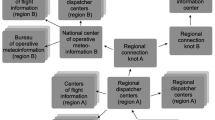Abstract
The object of research is the methods for monitoring and forecasting strong space weather disturbances affecting the radiation environment and radio communication during air travels. The monitoring techniques used by the existing space weather centers are analyzed: the U.S. Center, the PECASUS consortium (Great Britain, Finland, Germany, Poland, Austria, Italy, the Netherlands, Belgium, Cyprus, and South Africa), the AJCF consortium (Australia, Japan, Canada, France), and the Russian-Chinese space weather consortium.



Similar content being viewed by others
REFERENCES
O. A. Barsukov and E. V. Kolomeets, Radiation Aspects of Studying Cosmic Rays in the Stratosphere (Energoatomizdat, Moscow, 1985) [in Russian].
V. A. Burov, Yu. S. Meleshkov, and Yu. P. Ochelkov, “The Technique for Operational Evaluation of the Level of Radiation Danger due to Space Weather Disturbances during Air Travel,” Geliogeofizicheskie Issledovaniya, No. 7 (2014) [in Russian].
V. A. Burov and Yu. P. Ochelkov, Nowcasting the Appearance of Geoeffective Proton Fluxes in the Near-Earth Space, Bulletin No. 17 (Federal Service for Intellectual Property, 2013) [in Russian].
V. A. Burov and Yu. P. Ochelkov, “Predicting Intensity of Solar Proton Events with Proton Energy 10–100 MeV Based on Flare X-rays,” in Proceedings of the Conference “Solar and Solar-terrestrial Physics–2019” (VVM, St. Petersburg, 2019) [in Russian].
EPCARD, https://www1.helmholtz-muenchen.de/epcard/online/fluginput.php?lang=de.
GOES-14 Solar X-ray Flux, ftp://ftp.swpc.noaa.gov/pub/lists/xray/.
J. K. Hargreaves and M. Friedrich, “The Estimation of D-region Electron Densities from Riometers Data,” Ann. Geophys., 21 (2003).
S. W. Kahler, S. M. White, and A. G. Ling, “Forecasting E > 50-MeV Proton Events with the Proton Prediction System (PPS),” J. Space Weather Space Climate, 7 (2017).
M. Laurenza, E. W. Cliver, J. Hewitt, M. Storini, A. G. Ling, C. C. Balch, and M. L. Kaiser, “A Technique for Short-term Warning of Solar Energetic Particle Events Based on Flare Location, Flare Size, and Evidence of Particle Escape,” Space Weather, 7 (2009).
C. J. Mertens, M. M. Meier, S. Brown, R. B. Norman, and X. Xu, “NAIRAS Aircraft Radiation Model Development, Dose Climatology, and Initial Validation,” Space Weather, 11 (2013).
NAIROS, http://sol.spacenvironment.net/raps_ops/current_files/globeView.html.
W. M. Neupert, “Comparison of Solar X-ray Line Emission with Microwave Emission during Flares,” Astrophys. J., 153 (1968).
Author information
Authors and Affiliations
Corresponding author
Additional information
Translated from Meteorologiya i Gidrologiya, 2021, No. 3, pp. 102-110. https://doi.org/10.52002/0130-2906-2021-3-102-110.
About this article
Cite this article
Aleshin, I.M., Arakelov, A.S., Bruevich, E.A. et al. Methods for Monitoring Strong Space Weather Disturbances to Support International Air Navigation. Russ. Meteorol. Hydrol. 46, 205–211 (2021). https://doi.org/10.3103/S1068373921030109
Received:
Published:
Issue Date:
DOI: https://doi.org/10.3103/S1068373921030109




